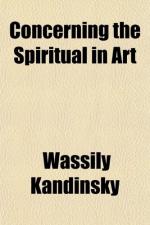The achievement of the dance-art of the future will make possible the first ebullition of the art of spiritual harmony—the true stage-composition.
The composition for the new theatre will consist of these three elements:
(1) Musical movement
(2) Pictorial movement
(3) Physical movement
and these three, properly combined, make up the spiritual movement, which is the working of the inner harmony. They will be interwoven in harmony and discord as are the two chief elements of painting, form and colour.
Scriabin’s attempt to intensify musical tone by corresponding use of colour is necessarily tentative. In the perfected stage-composition the two elements are increased by the third, and endless possibilities of combination and individual use are opened up. Further, the external can be combined with the internal harmony, as Schonberg has attempted in his quartettes. It is impossible here to go further into the developments of this idea. The reader must apply the principles of painting already stated to the problem of stage-composition, and outline for himself the possibilities of the theatre of the future, founded on the immovable principle of the inner need.
From what has been said of the combination of colour and form, the way to the new art can be traced. This way lies today between two dangers. On the one hand is the totally arbitrary application of colour to geometrical form—pure patterning. On the other hand is the more naturalistic use of colour in bodily form—pure phantasy. Either of these alternatives may in their turn be exaggerated. Everything is at the artist’s disposal, and the freedom of today has at once its dangers and its possibilities. We may be present at the conception of a new great epoch, or we may see the opportunity squandered in aimless extravagance.
[Footnote: On this question see my article “Uber die Formfrage”— in “Der Blaue Reiter” (Piper-Verlag, 1912). Taking the work of Henri Rousseau as a starting point, I go on to prove that the new naturalism will not only be equivalent to but even identical with abstraction.]
That art is above nature is no new discovery. [Footnote: Cf. “Goethe”, by Karl Heinemann, 1899, p. 684; also Oscar Wilde, “De Profundis”; also Delacroix, “My Diary".] New principles do not fall from heaven, but are logically if indirectly connected with past and future. What is important to us is the momentary position of the principle and how best it can be used. It must not be employed forcibly. But if the artist tunes his soul to this note, the sound will ring in his work of itself. The “emancipation” of today must advance on the lines of the inner need. It is hampered at present by external form, and as that is thrown aside, there arises as the aim of composition-construction. The search for constructive form has produced Cubism, in which natural form is often forcibly subjected to geometrical construction, a process which tends to hamper the abstract by the concrete and spoil the concrete by the abstract.




